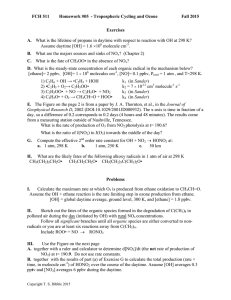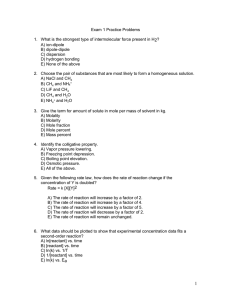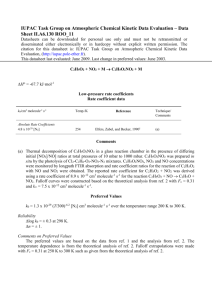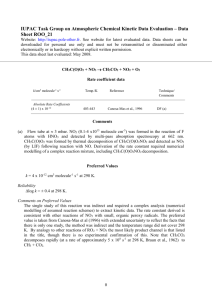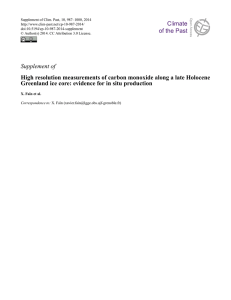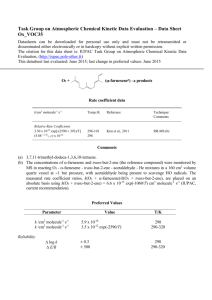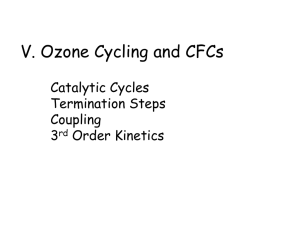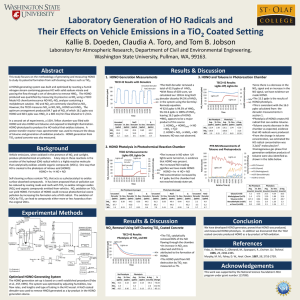FCH 511 Homework #6 Fall 2015 10
advertisement
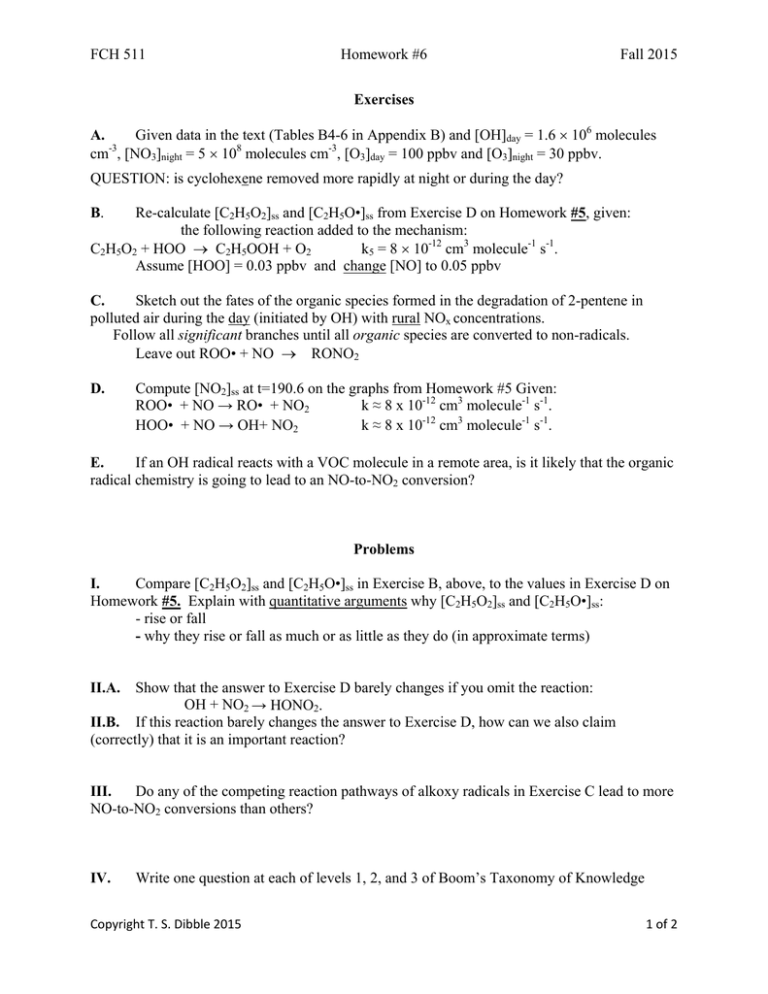
FCH 511 Homework #6 Fall 2015 Exercises A. Given data in the text (Tables B4-6 in Appendix B) and [OH]day = 1.6 106 molecules cm-3, [NO3]night = 5 108 molecules cm-3, [O3]day = 100 ppbv and [O3]night = 30 ppbv. QUESTION: is cyclohexene removed more rapidly at night or during the day? Re-calculate [C2H5O2]ss and [C2H5O•]ss from Exercise D on Homework #5, given: the following reaction added to the mechanism: C2H5O2 + HOO C2H5OOH + O2 k5 = 8 10-12 cm3 molecule-1 s-1. Assume [HOO] = 0.03 ppbv and change [NO] to 0.05 ppbv B. C. Sketch out the fates of the organic species formed in the degradation of 2-pentene in polluted air during the day (initiated by OH) with rural NOx concentrations. Follow all significant branches until all organic species are converted to non-radicals. Leave out ROO• + NO RONO2 D. Compute [NO2]ss at t=190.6 on the graphs from Homework #5 Given: ROO• + NO → RO• + NO2 k ≈ 8 x 10-12 cm3 molecule-1 s-1. HOO• + NO → OH+ NO2 k ≈ 8 x 10-12 cm3 molecule-1 s-1. E. If an OH radical reacts with a VOC molecule in a remote area, is it likely that the organic radical chemistry is going to lead to an NO-to-NO2 conversion? Problems I. Compare [C2H5O2]ss and [C2H5O•]ss in Exercise B, above, to the values in Exercise D on Homework #5. Explain with quantitative arguments why [C2H5O2]ss and [C2H5O•]ss: - rise or fall - why they rise or fall as much or as little as they do (in approximate terms) Show that the answer to Exercise D barely changes if you omit the reaction: OH + NO2 → HONO2. II.B. If this reaction barely changes the answer to Exercise D, how can we also claim (correctly) that it is an important reaction? II.A. III. Do any of the competing reaction pathways of alkoxy radicals in Exercise C lead to more NO-to-NO2 conversions than others? IV. Write one question at each of levels 1, 2, and 3 of Boom’s Taxonomy of Knowledge Copyright T. S. Dibble 2015 1 of 2 FCH 511 Homework #6 Fall 2015 (defined below). That is a total of three (3) questions, only! The questions should be based on the material in section 16.A.1 of the book by Finlayson-Pitts and Pitts (on reserve at Moon Library). Questions should be designed so that they can be answered without using resources other than the specified section of the Finlayson-Pitts and Pitts general concepts taught in the course minimal use of a calculator (for example, no Arrhenius expressions) Finally, specify whether the answer should be quantitative, qualitative, a calculation, or some combination. Table 2. Bloom‘s Taxonomy of Knowledge (a famous way to think about levels of knowledge) Level Of Learning 1. Information 2. Knowledge / Comprehension 3. Knowledge Skill / Application 4. Problem Solving 5. New Knowledge (Research) Examples What is the average [CH4] in atmosphere? The answer is a data point which is in the book. Why is [CH4] greater than [CO] in the atmosphere despite the fact that CO emissions are much larger than [CH4] emissions? You need to recall the reason from the answer in Homework #3. This would be a level 3 question if you forgot that you answered this already and thought through it again. Given a compound, X, emitted at 1% the rate of CH4 but whose lifetime is 500 years, which compound will be at higher concentration in the atmosphere? You need to apply steady state calculation or concepts, plus the [CH4] lifetime, to determine the answer. Given a data set for emissions and concentration of an anthropogenic species versus location and time, determine its approximate tropospheric lifetime. Consider this a major project, the procedure for which you need to determine. Design and carry out a field campaign and analysis to determine the rate of transport of CO between the Northern and Southern hemispheres. Research for a PhD or two! Copyright T. S. Dibble 2015 2 of 2
